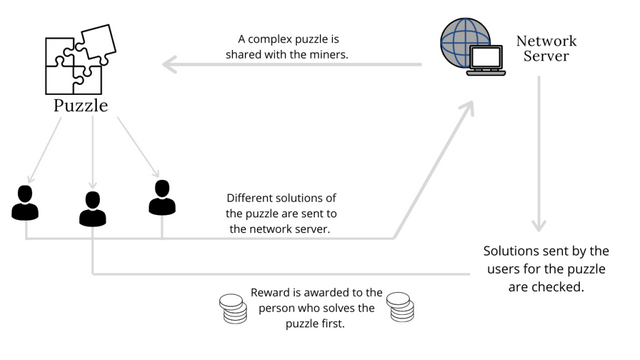Steemit Crypto Academy season 5 - Different types of Consensus Mechanisms, Homework post, Task-6 by @Sahmie
Today, I am taking another step further with my introductory classes to the crypto world as I write my sixth homework task. without further ado, let's get to the business of the day.
QUESTION 1
What Is The Difference Between PoW & PoS? Advantages & Disadvantages? Which One Is Better In Scaling Capacity? Examples?
INTRODUCTION
Have you ever wondered how digital currencies easily function without intermediary bodies or banks with verified transactions? The means which ensures such smooth working is known as ‘Consensus Mechanism’.
Public blockchains which operate as decentralized, self-regulating networks work on a universal scale without any form of authority. They involve contributions from millions of participants who work on validating and authenticating transactions occurring on the blockchain.
As such, changing the status of the blockchain dynamically. These publicly shared ledgers need a fair, real-time, active, credible, secure and efficient mechanism to ensure that all the transactions happening on the network are genuine and all parties agree on a consensus on the stature of the ledger. This all-important assignment is executed by the consensus mechanism. Then comes the question of what consensus mechanism is all about.
WHAT IS A CONSENSUS MECHANISM?
A consensus mechanism is a procedure that is followed by all participants of a network in a decentralized system in other for them all to reach a shared ledger state in fairness.
In other words, consensus mechanisms are used to attain agreement on a single data value among participants in distributed processes or systems. with the sole aim of achieving dependability in a network involving multiple unreliable nodes.
Consensus mechanisms are applied in other to:
- Decide whether to execute a distributed transaction to a database.
- Designate node as a leader for some allotted task.
- Synchronize state machine models and assuring consistency among them.
The quest to design and carry out a reasonable decentralized network control model that balances all these three attributes lead to the discovery of various networks with different blockchain consensus mechanisms that best suit their strategic priorities.
Proof of Work(PoW) and Proof of Stake(PoS) are among examples of these consensus mechanisms, that enables these peer-to-peer transactions to happen.

WHAT IS THE DIFFERENCE BETWEEN PoW & PoS?

Before heading into the details of their differences, let us get to know what PoW and PoS are all about.
PROOF OF WORK (PoW)
The Proof of work mechanism relies on the intellectual ability of the miners to solve complicated cryptographical problems in other to solve the blocks containing transactional data.
When a transaction is launched, miners of the blockchain use their “supercomputers” to unravel a cryptographic puzzle where the answer to the puzzle tells them of the next block to be attached to the blockchain. Thus, the first miner to solve the puzzle is rewarded with freshly minted crypto for his work.
Under this mechanism, the miners compete against one another to complete the transactions and earn rewards for doing it in the least amount of time.
PROOF OF STAKE (PoS)
The Proof of Stake (PoS) consensus mechanism relies on a probability model for assigning validators in which the probability of a validator earning a block to solve is directly proportional to the amount of their staking to secure the network. Thus, the stake is held as collateral that can be seized if any wrongdoing is detected on the part of the validator.
 Designed using pixellab
Designed using pixellab
This model allows owners of a cryptocurrency to pledge their cryptos and create their authenticating nodes. Staking is simply the placing of a certain amount of the network’s currency in a wallet related to its blockchain. Therefore, the validators of blocks are selected depending on the amount/nature of their stake.
When a block of transactions is ready to be processed, the PoS protocol will assign a validator node to evaluate the block. The validator cross-checks if the transactions in the block are valid. If so, the block is then added to the
blockchain and earn crypto dividends for their contribution. But, if a validator endorses the adding of a block with false or incorrect evidence, the validator stands to lose some of his staked cryptos as a penalty.
Differences between PoW and PoS are listed below;
| PROOF OF WORK (PoW) | PROOF OF STAKE (PoS) |
|---|---|
| involves miners | Involves validators. |
| Blocks are mined | Blocks are minted/forged. |
| There is competition among miners | Nodes are randomly chosen. |
| Involves how much computational work is done by miners. | Validating a new block is determined randomly based on the staked amount |
| A reward is given to the first miner to solve the cryptographic puzzle of each block | the validator does not receive a block reward instead they collect a network fee as their reward. |
| PoW requires a lot of electricity energy | PoS systems consume less energy |
| Requires specialized equipment to optimize processing power. | Any standard server-grade unit is enough. |
| The initial investment is to buy hardware | Initial investment is to buy a stake and build a reputation. |
ADVANTAGES AND DISADVANTAGES

Both PoW and PoS have their pros and cons which I will explain to you.
PROS OF PoW
PoW provides a solid means for accomplishing consensus and preventing abuses and misuses, as a peer-to-peer network of users maintains the database by achieving consensus or agreeing on things like the order of transactions and account balances.
PoW is fundamentally for authenticating transactions without the need for a third party, as well as for preventing individuals or organizations from tampering with the database. The mechanism renders it difficult to modify any aspect of the ledger of transactions, thus guaranteeing the genuineness and traceability of each transaction.
PoW depends on computational capabilities. Although it is theoretically possible for an individual to tamper with the blockchain, doing so would require expanding computing capabilities that are futile and uneconomical to the point that the cost considerably outweighs the gains or benefits.
CONS
- PoW is highly expensive as a good processing computer is required.
- Additional peripherals to a PC cost a lot.
- It involves complex puzzles and useless calculations.
- It tends to make the blockchain more centralized as only those with supercomputers can solve these puzzles as opposed to decentralized.
- PoW systems consumes a ton of energy.
- Under PoW, cryptos mined are limited, thus, the mining goes on becoming difficult.
PROS OF PoS
- Involves rapid processing of transactions
- The number of coins retained increases in ratio to the increase in rewards, therefore once the coin appreciates, the value of your wallet appreciates too.
- One can use the cash meant for the purchase of mining machinery to purchase additional coins and stake them. This will eventually lead to an increase in value and balance.
- Fewer resources are used when staking compared to the resources used by PoW (Proof of Work) and mining. Resulting in less energy consumption.
- Because the holder of the coin is motivated by the profit for holding them instead of selling them, the price of such coins will be very stable.
- Little or no technical experience is needed to participate in staking.
CONS
- Once a coin is invested, it is difficult for you to sell that coin until the planned staking period has elapsed.
- PoS security model is young and not yet proven to work as well as proof of work.
- Rewards aren’t as much.
WHICH ONE IS BETTER IN SCALING CAPACITY? EXAMPLES?

In the context of which is better between PoW and PoS, I choose PoS for reasons being that;
- Proof of Stake saves energy and reduces barriers to access. Therefore, reducing money spent on buying hardware and electricity for development and other initiatives.
- Under PoS, the amount of crypto possessed increases in proportion to the increase in rewards, therefore, the appreciation in the value of the crypto will also lead to the appreciation of your wallet too.
- Since it doesn't involve buying mining machines, one can use the cash meant for the purchasing of mining machinery to purchase more crypto and stake them which will eventually lead to an increase in value and balance.
- Because the owner of the crypto is encouraged by the profit to hold them rather than selling them, the price of such crypto will be very stable.
- PoS is easier to start as one does not necessarily need to have any specialized experience to particle in staking.
Examples would be Ethereum as they plan to launch a Proof of Stake system called ‘Casper’ which they are developing on the Ethereum network. Another example is the project called ‘Cardano’ as they have been working on creating a better secure Proof of Stake algorithm called ‘Ouroboros’.

CONCLUSION
Proof of Stake was inaugurated to overcome the difficulties faced by miners in Proof of Work. And due to the multiple disadvantages such as high consumption of energy, Proof of Work is looking most likely to lose its existence in the future.
Thus, making it difficult for users to decide which mechanism to apply since proof of work is tested and trusted by some of the heavyweights in cryptocurrency such as Bitcoin. So decide by yourself, if you want to be a Miner or a Validator.
Cc;
@sapwood




Upvoted! Thank you for supporting witness @jswit.
